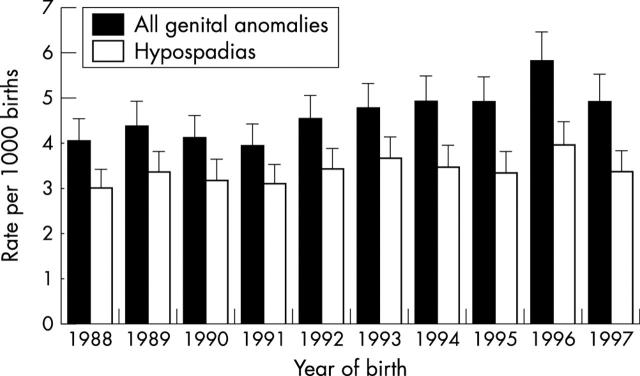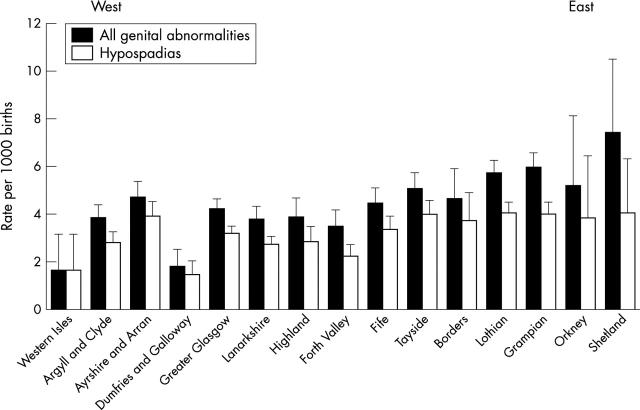Abstract
Background: Considerable debate exists on the epidemiology of genital anomalies.
Methods: All genital anomalies, excluding undescended testes, were identified from neonatal returns, stillbirth and infant death survey records, and returns relating to hospital admissions and linked to form infant profiles on a cohort of singleton births between 1988 and 1997 with follow up for a minimum of three years.
Findings: The mean genital anomaly prevalence rate in Scotland was calculated at 4.6 per 1000 births varying from 4.0 per 1000 births in 1988 to 5.9 per 1000 births in 1996. However, there was no evidence of a clear trend to an increasing prevalence of hypospadias, which constituted 73% of the anomalies studied. Logistic regression analysis of the data also showed this rate to be independently associated with being relatively small for gestational age (odds ratio (OR) 1.43, p < 0.001) and increasing maternal age (OR 1.2, p < 0.05). Infants born in deprived areas, as judged by the Carstairs deprivation score, were least likely to have a genital anomaly (OR 0.73, p < 0.01).
Interpretation: A new linked register of congenital genital anomalies in Scotland suggests that over a decade, the birth prevalence of genital anomalies has changed little. The associations between genital anomalies, maternal age, and socioeconomic deprivation require further study.
Full Text
The Full Text of this article is available as a PDF (190.5 KB).
Figure 1 .
Prevalence rates (per 1000 births) for all genital anomalies and hypospadias between 1988 and 1997. Error bars denote 95% confidence interval.
Figure 2 .
Prevalence rates (per 1000 births) between 1988 and 1997 for all genital anomalies and hypospadias in the 15 health boards of Scotland. The health boards on the left are located on the western side of Scotland and those on the right are located on the eastern side. Error bars denote 95% confidence interval.
Selected References
These references are in PubMed. This may not be the complete list of references from this article.
- Ahmed S. Faisal, Hughes Ieuan A. The genetics of male undermasculinization. Clin Endocrinol (Oxf) 2002 Jan;56(1):1–18. doi: 10.1046/j.1365-2265.2002.01430.x. [DOI] [PubMed] [Google Scholar]
- Dolk H. Rise in prevalence of hypospadias. Lancet. 1998 Mar 14;351(9105):770–770. doi: 10.1016/S0140-6736(05)78924-8. [DOI] [PubMed] [Google Scholar]
- Fisch H., Golden R. J., Libersen G. L., Hyun G. S., Madsen P., New M. I., Hensle T. W. Maternal age as a risk factor for hypospadias. J Urol. 2001 Mar;165(3):934–936. [PubMed] [Google Scholar]
- Hussain Naveed, Chaghtai Azhar, Herndon C. D. Anthony, Herson Victor C., Rosenkrantz Ted S., McKenna Patrick H. Hypospadias and early gestation growth restriction in infants. Pediatrics. 2002 Mar;109(3):473–478. doi: 10.1542/peds.109.3.473. [DOI] [PubMed] [Google Scholar]
- Kendrick S., Clarke J. The Scottish Record Linkage System. Health Bull (Edinb) 1993 Mar;51(2):72–79. [PubMed] [Google Scholar]
- Källén B., Bertollini R., Castilla E., Czeizel A., Knudsen L. B., Martinez-Frias M. L., Mastroiacovo P., Mutchinick O. A joint international study on the epidemiology of hypospadias. Acta Paediatr Scand Suppl. 1986;324:1–52. doi: 10.1111/j.1651-2227.1986.tb14935.x. [DOI] [PubMed] [Google Scholar]
- Källén B. Case control study of hypospadias, based on registry information. Teratology. 1988 Jul;38(1):45–50. doi: 10.1002/tera.1420380107. [DOI] [PubMed] [Google Scholar]
- Paulozzi L. J., Erickson J. D., Jackson R. J. Hypospadias trends in two US surveillance systems. Pediatrics. 1997 Nov;100(5):831–834. doi: 10.1542/peds.100.5.831. [DOI] [PubMed] [Google Scholar]
- Vrijheid M., Dolk H., Stone D., Abramsky L., Alberman E., Scott J. E. Socioeconomic inequalities in risk of congenital anomaly. Arch Dis Child. 2000 May;82(5):349–352. doi: 10.1136/adc.82.5.349. [DOI] [PMC free article] [PubMed] [Google Scholar]
- Weidner I. S., Møller H., Jensen T. K., Skakkebaek N. E. Risk factors for cryptorchidism and hypospadias. J Urol. 1999 May;161(5):1606–1609. [PubMed] [Google Scholar]
- de Zegher F., Francois I., Boehmer A. L., Saggese G., Müller J., Hiort O., Sultan C., Clayton P., Brauner R., Cacciari E. Androgens and fetal growth. Horm Res. 1998;50(4):243–244. doi: 10.1159/000023284. [DOI] [PubMed] [Google Scholar]




